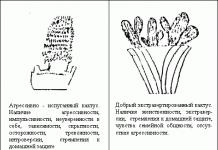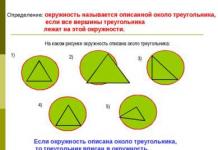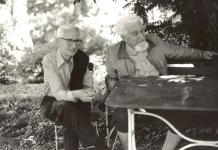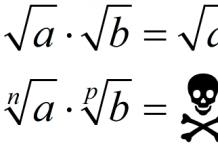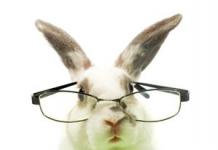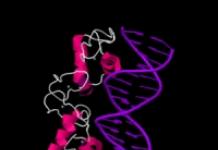Based on the structure and location of its organs, humans belong to the class of mammals. Most essential features, inherent in both humans and mammals, are the mammary, sebaceous and sweat glands, body hair, specialized teeth (incisors, canines, premolars and molars), a four-chambered heart and the left aortic arch, pulmonary breathing, the presence of a diaphragm, a highly developed brain , intrauterine development of the embryo, feeding the baby with milk. Both humans and animals have common links in tissue metabolism, growth and individual development, one for everything organic world principle of storage and implementation genetic code etc. The maximum similarity of a person is found with representatives of the family great apes, or anthropoids: gorilla, chimpanzee, orangutan, gibbon. Community internal structure humans and anthropoids are complemented by external similarities: they have a single structure of the upper and lower extremities, the absence of a tail, very similar auricles, the presence of fingernails, etc.
It is almost impossible to distinguish between human primate and other vertebrate embryos in the early stages of development. The human embryo develops a notochord, gill grooves, gill arches and a corresponding network of blood vessels, similar to
as is the case with the most ancient shark fish. During the process of embryonic development, a number of other similar signs appear and then disappear in humans, but some of them remain in the form rudiments, indicating a clear connection with the animal world. These include: the coccyx - the remnant of the tail, expressed in the spine of the embryo at the age of 1.5-3 months of intrauterine development, outer hair, the vermiform appendix of the cecum, subcutaneous muscles, which are developed in humans only on the face and there is a subcutaneous muscle in the form of a rudiment ear muscle, etc. In total, humans have more than 90 rudiments.
A. N. Severtsov (1866-1936) pointed out that the development of the embryo of a modern vertebrate makes it possible to judge not so much what the adult forms of the ancestors of vertebrates were, but rather what their embryonic forms were, since many significant changes in the body structure of the hereditary character occur during embryonic development and are reflected in the structure of adult forms in subsequent generations.
There is no doubt, however, that the study of embryonic forms allows us to judge a number of structural features in adult ancestral forms, especially since reproduction and transmission of characteristics occurs through adult forms, and not through embryos.
Human embryos five to six days old already have mesodermal segments. The phenomenon of segmentation in the structure of the muscles of the human embryo indicates the stage of the most ancient chordates, from which it also inherited, for example, the dorsal chord, primary renal buds (anterior buds), and traces of the caudal gut.
At the age of several weeks, the embryos of humans and other mammals show many similarities to fish. Gill grooves develop on the sides of the cervical and head regions. Circulatory system similar to that characteristic of -fish: a two-chambered heart, a caudal artery, blood vessels consisting of six aortic arches, suitable for the gill arches. Join here: general shape embryonic bodies, tail, gill grooves, filamentous continuation of the posterior part of the spinal cord.
All this convinces us that one of the most ancient ancestors of humans, as well as other higher vertebrates, were fish. Some features of the “fish stage” of development can manifest themselves in humans in the form of atavisms. An example is cervical fistulas communicating with the pharynx.
At this same early stage, the human brain still has a very primitive structure, however, like all other vertebrates, it is already divided into three primary brain vesicles: anterior, middle and posterior.
The anterior cerebral vesicle forms the olfactory lobes, followed by the forebrain of two hemispheres (in each of them there is a cavity - the first and second ventricles), and even further down the diencephalon (in it there is a cavity - the third ventricle, then the pineal gland and pituitary gland).
The middle cerebral vesicle subsequently turns into the mesencephalon: the so-called “quadrigeminal” is formed on the upper side. The canal inside the midbrain, otherwise known as the aqueduct of Sylvius, communicates with the cavity of the fourth ventricle, which forms in the hindbrain and medulla oblongata. From the lower part of the midbrain arise the legs of the cerebrum, which, together with its hemispheres, is formed from the forebrain and middle sections of the brain.
Finally, the posterior medullary vesicle gives rise to the pons, cerebellum and medulla oblongata, within which the fourth ventricle is formed. The medulla oblongata directly passes into the spinal cord, and the cavity of the fourth ventricle into the spinal canal.
Of modern vertebrates, we find a comparatively very primitive brain in fish. The forebrain hemispheres of the fish are very small and have small olfactory lobes. There are almost no cross connections between the hemispheres, which already develop in amphibians and reptiles. However, cross-connections that arise with the complication of the brain are especially characteristic of the brains of most mammals, which are the most highly developed vertebrates.
The midbrain of a fish is represented mainly by the visual colliculus and is the largest part of the brain, since it is eight to nine times larger than the hemispheres in volume. The diencephalon, located between the hemispheres and the midbrain, carries brain appendages in fish: at the top is the pineal gland, at the bottom is the pituitary gland.
The pineal gland is an organ that is phylogenetically closely related to another, namely the parietal eye. The parietal eye, which has the ability to capture light rays, develops as an unpaired organ in some modern vertebrates. Among cyclostomes it is found in lampreys, and among reptiles in hatteria, roundhead, and monitor lizard. On the skulls of most fossilized ancient fish, amphibians and reptiles, a hole in the parietal eye is found. From this we can assume that the parietal eye was also developed in our very distant ancestors - lower vertebrates.
The pituitary gland is of even greater interest. Judging by the structure of this organ in cyclostomes (namely, in hagfishes, in which the pituitary gland tube opens outward with a hole on the head in front of the eyes, and communicates with the intestines at the inner end), it is also very ancient education. The pituitary gland is closely related to the initial part of the digestive tract with the oral part and gill system, and its anterior part is a derivative of the protrusion of the primary oral cavity. In his own posterior section The pituitary gland is formed from the transformed lower, tapering end of the infundibulum of the intermediate portion of the brain.
The pituitary gland and pineal gland were previously considered completely mysterious organs. At one time, the philosopher Descartes even suggested the seat of the soul in the pineal gland. But there is nothing particularly mysterious about them: these ancient organs have changed very much and are now endocrine glands. The peculiarities of their development in humans indicate his relationship with the lowest vertebrates. In some adults, the unfused pituitary tube reaches the mucous membrane of the upper end of the pharynx, where sometimes even the so-called accessory pituitary glands are found. In the main, or sphenoid, bone of the skull, in 3-5% of cases there is a craniopharyngeal canal in the form of a remnant of a tube for the passage of the pituitary stalk (this canal is more common on chimpanzee skulls).
The pineal gland in the brain of the human embryo develops, as in modern vertebrates, behind the parietal organ, with which it is in some insufficiently clarified connection:
perhaps even, according to V.M. Shimkevich, both of these organs are relics of two paired formations that were related to the development of the organs of vision in our distant ancestors - lower vertebrates.
What did man inherit from the amphibian stage? This, according to some researchers, includes the swimming membranes that develop between the fingers of the human embryo. In the lower part of the human abdominal wall, tendon constrictions of the rectus muscles are inherited from amphibians.
Man also received the sciatic artery (a branch of the inferior gluteal artery) from amphibians. The case of a free central bone in the wrist skeleton of an adult is perhaps one of the examples of a return to the type of structure of amphibian ancestors.
In the olfactory department, humans have inherited from amphibians a part called Jacobson’s organ: it develops by the fifth month of uterine life in the form of a canal running from the nasal cavity to the oral cavity. Although at the end of uterine development this organ is reduced, it can still be found in an adult in the form of a short, blindly ending tubule, to which the endings of special nerves approach. The Jacobson organ is highly developed in ruminant mammals.
Finally, man inherited from ancient amphibians a remnant of their nictitating membrane in the form of the so-called semilunar fold, or lacrimal caruncle, in inner corner eyes. This fold corresponds to a well-developed nictitating membrane in modern amphibians, reptiles and birds, which is also present in some fish.
Among mammals, the nictitating membrane has undergone severe reduction, especially in cetaceans and most primates, but is significantly developed, for example, in rabbits, cats and some monkeys. Semilunate fold in humans - shining example rudiment.
From reptiles, humans have inherited a number of characteristics that are detected mainly in the uterine period, for example, in the development of the brain, in the structure and nature of the articulation of the limbs in a fetus of several months.
Further, as part of the anterior gill arch, from which the lower jaw is subsequently formed, Meckel's cartilage is formed in the embryo. Subsequently, like all mammals, it gives rise to two auditory ossicles, namely the malleus and the incus. Meanwhile, among our ancestors, cartilage, having experienced the process of ossification, served as an intermediary link in a complex connection between lower jaw and the skull, which is also observed in modern reptiles. The third auditory ossicle (stirrup), arising from the hyoid (hyoid) gill arch, is already present in one form or another in amphibians and reptiles.
The nature of the distribution of hair on the fetal body in groups - three and five pieces, to a certain extent corresponds to the way the scales are arranged on skin ancient reptiles that served as the ancestors of mammals.
Among the later ancestors of man were ancient mammals, as evidenced by large quantity facts. Thus, the brain of a human fetus at the early stages of development, with its smooth surface and primitive structure, strongly resembles the brain of modern lower mammals (these features were inherited by humans, probably from their Mesozoic forms).
The kinship of man with lower mammals is also evidenced by other primitive features found in his ontogeny. For example, in a six-week-old human embryo, the buds of several pairs of mammary glands form along the mammary lines. A rather dense, although small, hair fluff, otherwise known as lanugo, develops throughout the body (except for the palms and soles). In the oral cavity, noticeable ridges are formed on the soft palate, in a pronounced form so characteristic of monkeys, carnivores and other mammals.
At the age of 1.5-3 months, the caudal section is noticeably pronounced, in which the final section of the rudimentary spinal column with 8-9 vertebral anlages can be found. By the end of this period, the outer section of the tail is reduced and retracted. In the internal part of the caudal region, from 6 to 2 vertebrae are preserved, called coccygeal vertebrae and usually tightly fused together into the coccyx, which in young men and women, as a rule, does not fuse with the sacrum.
Remaining as an exception and developing in some people, the last three characteristics and some others inherited from mammalian ancestors are cases of atavism. This includes, for example, the lack of curl of the auricle in many human fetuses. Some adults retain the shape of the so-called macaque ear. A similar form of the outer ear is characteristic of human fetuses at the age of five to six months and is apparently inherited from the fossil of the lower ape, which in some respects is similar to the macaque and forms one of the links in our family tree. In the case of incomplete wrapping of the shell helix, a small skin growth in the form of a tubercle, called “Darwin’s”, forms on its upper-lateral section.
Atavisms from the mammalian stage also include: unusually strong development of the ear muscles, allowing a person to move the auricle; development of the ventricles of the larynx to a depth of more than one centimeter; extra mammary glands, or nipples; rudiments of some extra teeth; excessive hairiness on the body and face; tail.
Every person has a vermiform appendix of the cecum, or appendix: this rudimentary organ is indisputable evidence that our ancestors at the stage of lower mammals had a rather long cecum. In some modern mammals, for example rodents and ungulates, an energetic process of digestion of food masses occurs in the cecum.
The appendix is one of the many rudiments of the human body. Extremely characteristic feature rudiments as residual organs is a strong variability of their shape, size and structure. Yes, when medium length The 8-9 cm appendix in humans sometimes reaches 20-25 cm, like in apes; it can be greatly shortened, up to 1-2 cm, and in very rare cases it is completely absent. Being rich in lymphoid tissue, especially at a young age, the appendix appears to correspond to some part of the cecum of other mammals that do not have an appendix .
It can be assumed that in the course of evolution, the ancestors of people partially or completely lost the following features: subtlety of smell, hair, most skin muscles, tail, grasping ability of the foot, signs in the jaws and intestines indicating a herbivorous lifestyle, guttural sacs, bicornuate uterus, pointedness of the auricle. In the females of later human ancestors, namely prosimians and apes, due to a decrease in the number of children born, a reduction of most of the mammary glands occurred, which, according to Darwin, was transmitted to the males of these ancestors.
Atavisms(from the Latin “atavus” - ancestor) represents characteristics that are absent in the closest, but characteristic of very distant human ancestors. For example, thick body hair, the appearance of additional nipples in women and men, cases birth people with a tail, etc. All these facts at one time gave the basis to Charles Darwin to come to the conclusion that humans and mammals descended from one common ancient ancestor.
Thanks to the development of facial muscles, anthropoids can express common emotions: crying, laughter, anger or excitement, etc. Anthropoids suffer from many diseases infectious diseases, inherent in man(tuberculosis, typhoid fever, infantile paralysis, dysentery, etc.) Down's disease occurs in chimpanzees ( mental retardation), the occurrence of which, as in humans, is associated with the presence in the animal’s karyotype of the third chromosome from the 21st pair. Similarities between blood groups were revealed. Biochemical and molecular studies have shown that in terms of the similarity of albumin proteins, chimpanzees, gorilla, and orangutans are closest to humans; in the baboon and the monkey these proteins have little resemblance to human proteins, and tarsiers and lemurs are very far from humans in this respect. Domestic biochemist A. N. Belozersky analyzed the results of molecular DNA hybridization to identify the degree of commonality of genetic information in the chromosomes of humans and some monkeys. It turned out that the number of similar nucleotide sequences in DNA in humans and chimpanzees was 91%, in humans and gibbons - 76%, in humans and rhesus macaques - 66%, i.e., the closer the animals are systematically to humans, the greater the difference between similarities between them molecular structure DNA.
Man has inherited from primates such features as broad shoulders and a wide flat chest, the common structure of the elbow and wrist joints, hands and the entire upper belt - those qualities that arose in monkeys thanks to the arboreal lifestyle.
Darwin paid special attention to proving the phylogenetic community of emotions and ways of expressing them, devoting a separate essay to them, closely related to The Descent of Man. In his essay “The Expression of Emotions in Man and Animals,” published in 1872, Darwin successfully showed that, according to the features of elementary mental activity and ways of expressing sensations, humans are undoubtedly genetically related to monkeys. Another important conclusion was that among the human races there are no psychic differences.
All the facts of this kind studied by Darwin, together with rudiments and atavisms, likewise led him to the conviction that man had a long pedigree, going deep into the history of the animal world, and that the last link before the first people was the fossil ape.
The ability to grasp and the opposition of the thumb to the rest, expressed in all primates, was not only preserved in humans, but continued to develop. Anthropoids are able to use suitable objects as “tools” or “weapons” to achieve a specific goal, which was the most important prerequisite for the emergence labor activity person.
The closeness of humans to anthropoids can also be traced in other characteristics, but each of the apes has only a certain set of characteristics that are most common to humans. For example, the gorilla, chimpanzee, and orangutan are closest in size to humans; in body weight and length of limbs - chimpanzees; in the shape of the femurs - gibbons; in the structure of the pelvic bones, feet and size of the brain - gorilla, etc. According to an anthropologist A. Kizsa, humans and gorilla have 385 in common morphological features, in humans and chimpanzees - 369, in humans and orangutans - 359. Gibbons and lower apes have 117-113 characteristics in common with humans.
In the first days of life, a newborn human surprises with its extreme tenacity. This feature serves as one of the indirect indications of human origin from animals that lived in trees, and indicates the ape stage in the human ancestry.
However, man is distinguished from the animal world fundamental biological differences, such as upright body position and walking on two legs, high degree development of hands and the ability to perform various, delicate and high-precision operations, a large volume of the brain, which is 2.5 times larger than the brain of anthropoids and 3.5 times its surface area, and, finally, speech, which is characteristic only of humans. It is no coincidence that Charles Darwin at one time concluded that none of the modern apes is the direct ancestor of humans. The human ancestry consists of a long chain of his predecessors; it goes back into the depths of time for tens of millions of years, and the last link before the first people was the fossil ape. A fossil predecessor of man, unknown during Darwin's lifetime, was subsequently discovered, confirming the scientist's scientific foresight.
Aristotle was the first to include man in the animal kingdom, placing him on the highest rung in the “Ladder of Creatures.” The outstanding Swedish naturalist Carl Linnaeus expressed the idea of the origin of man from ape-like ancestors. In his famous work, The System of Nature (1735), he placed humans in the same order as primates on the basis of morphological similarities. The same idea was later expressed by J-B. Lamarck (1809, “Philosophy of Zoology”) and the famous Russian evolutionist K.F. Roulier. Charles Darwin in his work “The Origin of Man and Sexual Selection” (1871), summarizing enormous material from the field of systematics, comparative anatomy, embryology, physiology, paleontology, provided strong evidence about common origin humans and apes. C. Darwin wrote: “If we do not deliberately close our eyes, then modern level knowledge we can approximately recognize our ancestors, and we have no need to be ashamed of them.”
The emergence of man as a biological species is the result of a long evolutionary process of development of the animal world. Man combines the fundamental features of structure and life activity that characterize animals. Anatomical and physiological features modern man distinguish it into a special biological species - Homo sapiens ( Homo sapiens) (Table 4).
Table 4
The position of man in the system of the organic world
The commonality of humans and vertebrates is confirmed by the commonality of their structure: skeleton, nervous system, circulatory, respiratory, digestive systems. The relationship between humans and animals is especially convincing when comparing their embryonic development (Figure 22).
Figure 22. Developmental stages of human and vertebrate embryos.
I – fish, II – newt, III – turtle, IV – bird, V – pig, VI – cow, VII – rabbit, VIII – man.
At the early stages of embryonic development, the human embryo is difficult to distinguish from the embryos of other vertebrates. In the embryonic period of development, the human embryo develops a two-chambered heart, six pairs of gill arches, and a caudal artery—signs of fish-like appendages. From amphibians, humans inherited the swimming membranes between the fingers, which are present in the embryo. Weak thermoregulation in newborns and children under 5 years of age indicates origin from animals with unstable body temperature. The fetal brain is smooth, without convolutions, like those of lower mammals of the Mesozoic era. A six-week-old embryo has several pairs of mammary glands. The caudal spine is also formed, which then turns into the coccyx. Thus, the main structural features and embryonic development confirm the animal origin of man. Specific (species) human characteristics arise only at the very latest stages of embryonic development.
Species characteristics of humans that distinguish them from other animals (in particular other mammals):
Upright walking;
The legs are longer than the arms, the foot is arched, the toes are short, the first toe is often the longest and does not deviate;
Strongly developed muscles of the lower extremities;
Very mobile skeleton of the arm, especially the hand; a hand with a large finger that is independent in its movement;
Very mobile shoulder joint, allowing rotational movements with a span of almost 180 0;
Spine with four curves;
Position of the pelvis at an angle of 60 0 to horizontal plane;
The neck articulation is located in the middle part of the base of the skull;
The face is short, almost vertical under the frontal part of the skull;
The jaws are small, with a rounded jaw arch;
The canines are usually no longer than the premolars, and there are no gaps in front or behind them;
Large volume of the brain skull compared to the facial part of the skull;
Most of the body is hairless;
Limited fertility.
The listed features of the structure and physiology of man are the result of the evolution of his animal ancestors. Important evidence of the relationship between man and animals are rudiments and atavisms. There are about 90 rudiments in the human body: the coccygeal bone (the remnant of a reduced tail); fold in the corner of the eye (remnant of the nictitating membrane); fine body hair (fur residue); process of the cecum - appendix, etc. All these rudiments are useless for humans and are the heritage of animal ancestors (Figure 23).

Figure 23. Human rudiments: A – third eyelid: 1 – human; 2 – birds; B – auricle: 1 – six-month embryo; 2 – adult; 3 – monkeys; B – cecum with vermiform appendix: 1 – human; 2 – ungulate.

Figure 24. Human atavisms: “lion boy”, tailed boy.

Figure 25. Humans and apes: a – skeletons: 1 – human, 2 – gorilla, 3 – orangutan, 4 – gibbon; b – brain: 1 – human, 2 – chimpanzee, 3 – orangutan.
Man has a very ancient evolutionary lineage. At the very beginning of the animal world stand the first living beings, who are thus the starting point of development for humans.
Based on the structure and location of its organs, humans belong to the class of mammals. The most significant features inherent in both humans and mammals are the mammary, sebaceous and sweat glands, body hair, specialized teeth (incisors, canines, premolars and molars), a four-chambered heart and the left aortic arch, pulmonary breathing, the presence of a diaphragm, highly developed brain, intrauterine development of the embryo, feeding the baby with milk.
Both humans and animals have common links in tissue metabolism, growth and individual development are carried out in a similar way, a common principle for the entire organic world for storing and implementing the genetic code, etc. The maximum similarity of humans is found with representatives of the family of great apes, or anthropoids: gorilla, chimpanzee, orangutan, gibbon. The commonality of the internal structure of humans and anthropoids is complemented by external similarities: they have a single structure of the upper and lower extremities, the absence of a tail, very similar ears, the presence of fingernails, etc.
Domestic biochemist A. N. Belozersky analyzed the results of molecular DNA hybridization to identify the degree of commonality of genetic information in the chromosomes of humans and some monkeys. It turned out that the number of similar nucleotide sequences in DNA in humans and chimpanzees was 91%, in humans and gibbons - 76%, in humans and rhesus macaques - 66%, i.e. The closer animals are to humans in a systematic sense, the greater the similarity between them in the molecular structure of DNA.
At one time, Charles Darwin provided convincing evidence of the phylogenetic community of emotions and ways of expressing them, devoting a separate essay to them, closely related to The Descent of Man. In his essay “The Expression of Emotions in Man and Animals,” published in 1872, Darwin successfully showed that in terms of the features of elementary mental activity and methods of expressing sensations, man is undoubtedly genetically related to monkeys. Another important conclusion is that there are no psychic differences among the human races.
However, man is distinguished from the animal world fundamental biological differences, such as an upright position of the body and movement on two legs, a high degree of development of the hands and the ability to perform a variety of delicate and high-precision operations, a large volume of the brain, which is 2.5 times larger than the brain of anthropoids and 3.5 times its surface area, and finally speech, which is characteristic only of man.
It is no coincidence that Charles Darwin at one time concluded that none of the modern apes is the direct ancestor of humans. The human ancestry consists of a long chain of his predecessors; it goes back into the depths of time for tens of millions of years, and the last link before the first people was the fossil ape. A fossil predecessor of man, unknown during Darwin's lifetime, was subsequently discovered, confirming the scientist's scientific foresight.
Test No. 1 “The place of man in the system of the organic world. Human evolution. Races of Man"
1. 1.Anthropogenesis is:
A) the doctrine of human development in the embryonic period;
B) the totality of life processes from birth to death of a person;
C) the science of the systematic position of man in living nature;
D) scientifically based idea about historical origin person.
2. A rudimentary formation in a person can be:
A) three-chambered heart;
B) six-fingered;
B) coccygeal bone;
D) multi-nipple.
3. It is assumed that the common ancestor of modern apes and humans was:
A) Pithecanthropus;
B) Australopithecus;
B) synanthropus;
D) Dryopithecus.
4. It is assumed that the link between animals and the first people were:
A) Dryopithecus;
B) australopithecus;
B) Pithecanthropus;
D) Cro-Magnons.
5. According to the main morphophysiological characteristics, a person of the modern type is classified as:
A) Sinanthropus;
B) a skilled person;
B) homo erectus;
D) a reasonable person.
6. Social essence person is manifested in:
A) dividing people into races;
D) the presence of a five-fingered limb.
24. Development on the body individuals large number nipples - example:
A) increasing complexity of the organization;
B) regeneration;
B) atavism;
D) adaptations to the environment.
25. Unlike apes, humans:
A) there is a Rh factor;
B) rational activity appeared;
B) there is a four-chambered heart;
D) abstract thinking is developed.
26. The human skull differs from the primate skull:
A) the presence of only one movable bone - the lower jaw;
B) the presence of sutures between the bones of the medulla;
B) a more developed brain part;
D) the structure of bone tissue.
27. A biological factor that ensures the development of thinking and work activity in humans, on early stage evolution is considered:
A) progressive brain development;
B) caring for offspring;
B) the appearance of a four-chambered heart;
D) an increase in the respiratory surface of the lungs.
28. The ability to make tools appeared for the first time among:
A) dryopithecus;
B) Ramapithecus;
B) australopithecines;
D) gibbons.
29. K driving forces anthropogenesis do not include:
A) the struggle for existence;
B) social way of life;
B) hereditary variability;
D) modification variability.
30. The similarity between humans and mammals indicates:
A) their relationship and general structural plan;
B) the same level of their organization;
B) their convergent similarity;
D) their origin from different ancestors.
2. The similarity between apes and humans is manifested in their commonality:
A) lifestyle
B) vertical body position
B) many diseases
D) chromosome set
D) structures of the skull and brain
E) main blood groups
3. Establish the sequence of stages of human evolution:
A) Cro-Magnon
B) Neanderthal
B) Australopithecus
D) Dryopithecus
D) Pithecanthropus
4. In connection with upright posture in humans
A) the upper limbs are freed
B) the foot takes on an arched shape
C) the thumb is opposed to the rest
D) the pelvis expands, its bones grow together
D) the cerebral part of the skull is smaller than the facial part
E) hair loss
Answers:
Test No. 1 “The place of man in the system of the organic world. Human evolution. Races of Man"
1G; 2B; 3G; 4B; 5G; 6B; 7B; 8V; 9G; 10B; 11G; 12B; 13V; 14V; 15G; 16A; 17A; 18A; 19G; 20B; 21B; 22A; 23A; 24V; 25B; 26V; 27A; 28V; 29A; 30A.
In this lesson you will learn about the relationship between humans and other animal species. Find out systematic position species Homo sapiens in the modern classification of living beings, get acquainted with the features that unite us with other mammals. The structural features of our body will also be considered, which distinguish humans from other animals and make our biological species unique and inimitable among other unique species.
Man like Living being, is part of the animal world. Our species belongs to the phylum Chordata, subphylum Vertebrates, class Mammals, subclass Placental mammals, order Primates, family Hominids, genus Homo sapiens (Diagram 1).
Scheme 1. The place of man in the system of living organisms
The fact that our species belongs to the kingdom Animalia is convincingly proven by our morphology, cytology and physiology.
Belonging to the phylum Chordata is visible at the stage of intrauterine development. The human embryo has a notochord, a neural tube located above the notochord, and a heart located on the ventral side under the digestive tract.
Human belonging to the Vertebrate subtype is determined by the replacement of the notochord with a spine, a developed skull and jaw apparatus, as well as two pairs of limbs (Fig. 1) and a brain consisting of five sections.

Rice. 1. The skeletons of humans and frogs have similar features that are characteristic of all vertebrates
The presence of hair on the surface of the body, five sections of the spine, a four-chambered heart, a highly developed brain, sweat, sebaceous, mammary glands, as well as warm-bloodedness allows us to classify a person as a mammal.
The development of the fetus inside the mother’s body in the uterus and its nutrition through the placenta belongs to the subclass of Placental mammals.
The presence of forelimbs of the grasping type, in which the first finger is positioned opposite to the other fingers, nails, well-developed clavicles, as well as the change of milk teeth in the process of ontogenesis and bearing, mainly, one baby allows us to classify a person as a member of the Primate order. At the order level, the similarity between humans and other animals ends.
The characteristics that allow us to separate the Human family from other primates are unique to humans. In the family Humans there is only one genus, Humans, in which there is only one modern look A reasonable person.
Let's look at the characteristics that distinguish humans from other animals.
First of all, this is higher nervous activity. A person has a developed second signaling system (see 8th grade lesson Higher Nervous Activity), which is responsible for the perception of speech, and also well-developed logical thinking, memory, and abstract thinking. These abilities arise due to the developed cerebral cortex. Humans have the largest ratio of brain mass to body mass of all animals.
The second difference is the skeletal features responsible for true upright posture. Our spine has 4 curves that optimally transfer the weight of our vertical body to our legs (Fig. 2).

Rice. 2. The human spine is adapted to true upright posture
And the legs have arched feet that can withstand the load when running and jumping (see video).
A flexible hand, in principle, is characteristic of many primates, but only in humans has it achieved such flexibility that it allows you to easily manipulate both small and heavy objects.
Moreover, the movements can be both powerful and very subtle, allowing, for example, embroidery or writing (see video).
Upright posture, developed hands and a powerful brain allowed man to produce tools - from a pointed stick to a space satellite (Fig. 3).


Rice. 3. Artifacts of ancient (spears - on the left) and modern (space satellite - on the right) people
Some birds and other primates are able to use found tools, such as stones and sticks. But none of them is able to make a special weapon for themselves.
The second signaling system made it possible to create a very highly organized society. No pack of animals is capable of such subtle and effective interaction as human society (see video).
Thus, from a biological systematics point of view, man is an animal from the order Primates. It has all the tissues and organ systems characteristic of other primates.
The human genotype differs from the genotype of the closest apes, such as bonobo pygmy chimpanzees, by one percent. At the same time, man, unlike animals, has a developed abstract thinking, able to produce and use tools. He exists in a society in which there is a division of labor and which is governed by speech.
Bibliography
- A.A. Kamensky, E.A. Kriksunov, V.V. Beekeeper. General biology, 10-11 grade. - M.: Bustard, 2005. Download the textbook from the link: ( )
- D.K. Belyaev. Biology 10-11 grade. General biology. A basic level of. - 11th edition, stereotypical. - M.: Education, 2012. - 304 p. (


